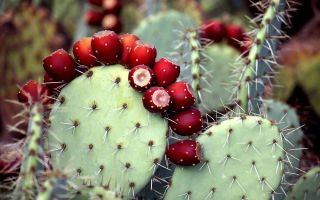Content
The medicinal properties of the prickly pear cactus are of interest to traditional medicine. The plant helps relieve symptoms of acute and chronic diseases due to its strong anti-inflammatory properties.
What it looks like and where it grows
Opuntia (Opuntia) is a plant from the Cactus family, represented by several hundred varieties. It has dense flattened oval stems that branch abundantly and extend up to 4 m above the ground. In good conditions, an adult cactus is a full-fledged shrub. Shoots of prickly pear are at the same time its fleshy oblong leaves.
The plant is densely covered with buds with groups of thorns and soft glochidia, blooms with yellow, orange and red single buds. Some of them subsequently set fragrant juicy fruits with flat seeds inside.
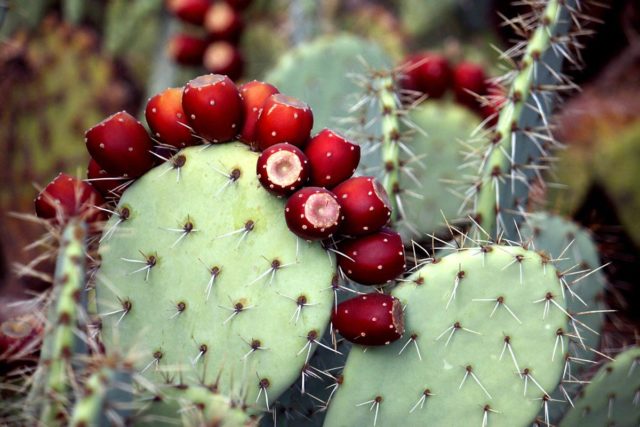
The culture is widespread in its natural form in Mexico, West Indies, North and South America. Found in the tropics and subtropics around the world as an imported plant. In Russia, you can see cacti in the Crimea.
Chemical composition
Photo and medicinal properties of prickly pear cactus are of interest to traditional medicine due to the rich composition of the plant. The shoots and fruits contain:
- protein compounds;
- vitamins B2, B3, B6 and B9;
- vitamin C;
- calcium, sodium and selenium;
- beta carotene;
- leucine and lysine;
- vitamin A;
- zinc, copper, potassium and magnesium;
- threonine and isoleucine;
- fatty acid;
- phosphorus and zinc;
- tryptophan.
Means based on a tropical cactus have a pronounced strengthening effect on the body.
Why prickly pear is useful
The prickly pear cactus is valued not only for its decorative properties. Medicines are prepared on its basis. In particular, the plant:
- relieves inflammation in diseases of the genitourinary system;
- relieves joint pain and eliminates bruises after bruises;
- improves the work of the cardiovascular system;
- helps with gastritis and stomach ulcers;
- improves metabolic processes and accelerates digestion;
- stops bleeding and disinfects wounds and cuts;
- evens out glucose levels in diabetes;
- has a fixing effect on diarrhea;
- promotes weight loss and removes toxins and toxins from the body;
- helps with headaches;
- improves skin and hair condition.
Funds based on prickly pear cactus are used for adenoma and prostatitis in men. The plant can be used for colds and for the treatment of pneumonia.
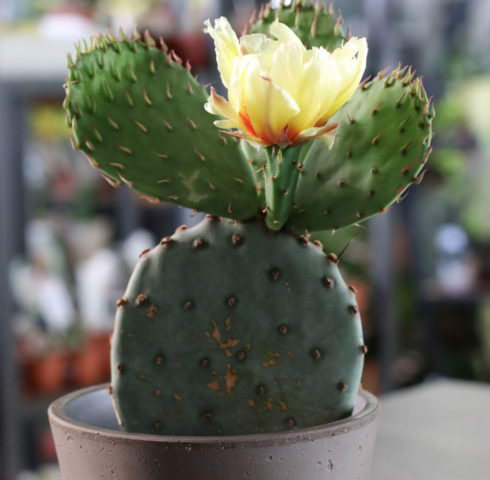
What are the benefits of prickly pear fruits
The edible berries of the prickly pear cactus are valued by folk medicine for their healing qualities. You can use them:
- with kidney problems and edema;
- with cystitis;
- with asthma and pneumonia;
- with inflammatory liver diseases;
- with diarrhea and bleeding;
- with diseases of the spleen;
- with varicose veins and thrombophlebitis;
- with high cholesterol levels and atherosclerosis;
- with intestinal infections.
The prickly pear fruits contain a large amount of vitamins and organic acids. Due to this, they can be used for anemia and as a prevention of scurvy.
Useful properties of prickly pear cactus oil
Opuntia oil has valuable medicinal properties; it is used in cosmetology and medicine. A product is prepared from plant seeds, and from 10,000 grains, only about 1 liter of pomace is obtained. This is the reason for its high cost. Cactus oil has a bright yellow or greenish color and a pleasant herbaceous scent.
The product is used to smooth the skin and eliminate fine wrinkles, to strengthen hair and treat dandruff. Cactus oil helps with sunburn and promotes the regeneration of damaged epidermis. It is used in aromatherapy for relaxation and added to soothing baths for stress and sleep problems.
Preparation and application methods
In folk medicine, water, oil and alcohol products are used based on the useful tropical cactus. Some of them can be bought in specialized stores, others are suitable for self-preparation from fresh raw materials.
Opuntia tincture
Tincture of prickly pear cactus on vodka has pronounced warming, strengthening and anti-cold properties. It is prepared according to this recipe:
- Grind 100 g of plant leaves, previously cleaned of thorns.
- Pour 500 ml of vodka into a glass container.
- Shake well and store in a dark place for 18 days.
- At the end of the period, filter.
Use the remedy in small portions of 15 drops three times a day for colds and inflammations.
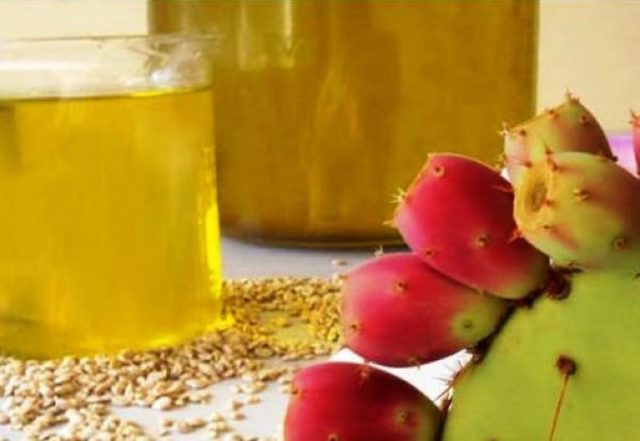
Opuntia oil
Cactus oil is usually not prepared at home; it must be bought in specialized stores. The product is obtained industrially by cold pressing from seeds.
Opuntia oil contains a large amount of vitamins E and K, linoleic acid and phytosterols. It is used mainly externally - for facial skin care, with premature aging of the epidermis, to eliminate the consequences of sunburn.
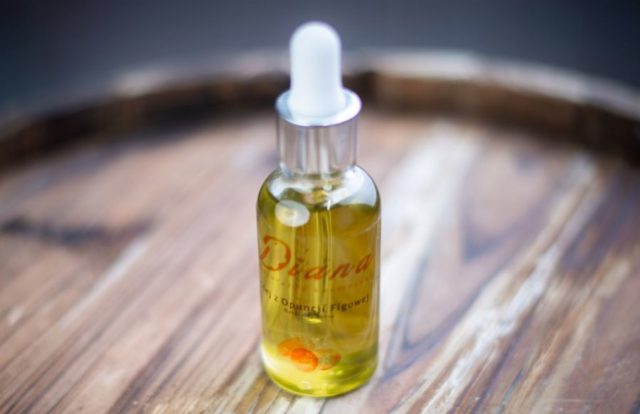
Application in traditional medicine
For medicinal purposes, you can use prickly pear tincture, healthy cactus juice and decoctions based on it. Traditional medicine recommends taking funds for a wide range of ailments, to strengthen immunity and with vitamin deficiency.
With rheumatism
For joint diseases, a strong tincture of prickly pear is especially beneficial. They do it like this:
- The green stems of the cactus are cleaned of needles and crushed in a volume of 200 g.
- In a dark glass vessel, pour 500 ml of high-quality vodka into gruel.
- For two weeks they are removed in the dark and cool.
- Remove regularly to shake.
The finished strained product is taken in 15-20 drops for acute inflammation and pain. You can also use the gruel of prickly pear leaves for compresses, it will help relieve puffiness and restore mobility to the joints.
With weakened immunity
To strengthen the immune system, traditional medicine recommends preparing a tincture on prickly pear flowers. The recipe looks like this:
- Large buds in the amount of 4-5 pieces are mixed with partitions from three walnuts.
- Pour the components with 500 ml of good vodka and shake.
- Remove the tincture for a week in a dark place.
- Filter through cheesecloth to remove sediment.
You need to take the drug 30 ml on an empty stomach.In total, treatment continues for no more than ten days, after which they take a mandatory break.
With pneumonia
The prickly pear cactus fights against bacterial processes in the lungs and promotes coughing up in pneumonia. The following broth is recommended for use:
- Several fleshy stems of the plant are crushed to obtain 50 g of gruel.
- The raw material is poured with cold water in a volume of 100 ml.
- Bring to a boil on the stove and cook for another half hour.
- Cool and filter.
You need to take a decoction of cactus in a small spoonful three times a day in between meals.

With ARVI
For a quick cure of a cold, traditional medicine advises to prepare a medicinal collection. They do it like this:
- Several blades of prickly pear are crushed and mixed with two large tablespoons of linden flowers.
- The raw material is steamed with 200 ml of hot water.
- Leave closed for 14 hours.
The ready collection is filtered and consumed three times a day after meals. A single dosage should be half a glass.
With asthma
Treatment with prickly pear is beneficial for bronchial asthma - the plant reduces the frequency of attacks. Tincture for therapy is prepared as follows:
- Mix 200 g of finely chopped green blades with 500 g of honey.
- Add 500 ml of quality Cahors.
- In a closed vessel, remove for 20 days in a darkened cabinet.
- They are filtering.
You need to take the tincture 15 ml three times a day before meals. In total, treatment is recommended for no longer than ten days in a row.
With diabetes
The prickly pear cactus evens out blood sugar levels and improves metabolic processes in diabetes. The plant is used as follows:
- The healthy green blades are cut and washed to remove contamination.
- Remove all thorns.
- Grind raw materials in a blender to the state of gruel.
The resulting mass should be taken three times a day before meals, 30 g each, washed down with a little water.
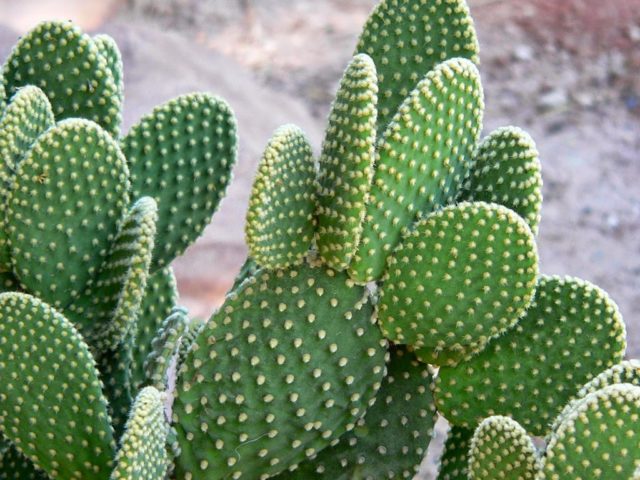
For intestinal upset
Opuntia helps to relieve pain in the intestines, normalizes peristalsis and improves the absorption of valuable substances. For medicinal purposes, it is recommended to take the following tincture:
- The green pulp of the cactus is chopped in a meat grinder or blender.
- Half a glass of gruel is mixed with a glass of sugar.
- Remove the mass in a dark place for three days.
- Add to the mixture 250 ml of fortified red wine and mix.
- Leave to infuse for another day.
The finished drink must be passed through folded gauze. They drink the tincture on an empty stomach, 15 m twice a day, in total it can be consumed for a month in a row.
When coughing
The prickly pear cactus helps to drain phlegm and makes a dry cold cough more productive. For treatment, such a remedy is prepared:
- The cactus blades are crushed and squeezed out with 10 ml of juice.
- Mix with 10 ml of medicinal marshmallow infusion.
- Add 10 g of liquid honey and bring the product until smooth.
You need to take a herbal medicine based on prickly pears three times a day after meals, two large spoons. Before use, it is allowed to warm it up a little, but only until warm.
With cystitis
With the inflammatory processes of the urinary tract, a decoction of prickly pear roots copes well. It is made according to the following algorithm:
- Medicinal raw materials are crushed using a blender or meat grinder and squeezed out the juice.
- Add to the remaining cake 50 ml of water.
- Once again passed through cheesecloth.
The ready-made mixture is consumed in 30 ml three times a day on an empty stomach.
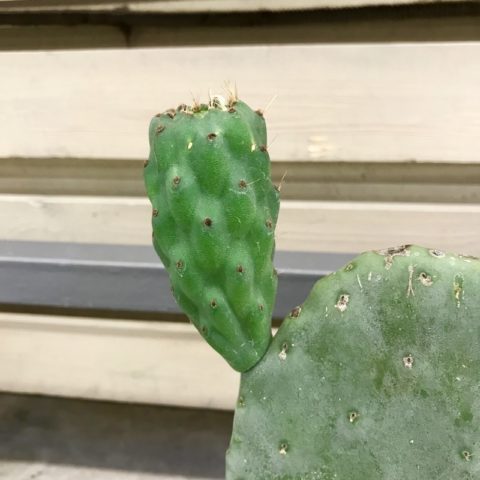
With gastritis
The properties of prickly pear accelerate digestion and are beneficial for gastritis with delayed production of hydrochloric acid. Traditional medicine recommends this recipe:
- The green stems of the plant are cut into three large spoons.
- Pour into a thermos and add chopped mandarin peel.
- Pour 500 ml of hot milk.
- Leave to infuse for 14 hours.
The filtered drink should be consumed three times a day, 125 ml each.
With prostatitis
A decoction of prickly pear cactus relieves pain and inflammation in prostatitis. During an exacerbation of the disease, it is recommended to use such a remedy:
- The prickly pear blades are finely chopped or chopped in a blender.
- Measure 50 g of gruel and pour 100 ml of cool water.
- Boil and then simmer over low heat for 25 minutes.
- Cool under the lid and filter.
The broth should be taken three times a day, 50 ml on a full stomach. The therapy is carried out for a month, then they take a break for three weeks and, if necessary, repeat the course.
Application in cosmetology
The valuable properties of prickly pear cactus are often used for skin care. The easiest way is to add a few drops of herbal seed oil to regular creams and masks. It is also allowed to apply the product to the skin in its pure form, rubbing gently until completely absorbed. It is important to control so that the squeeze does not get into the eyes, this can cause irritation.
Opuntia oil is also used:
- for the care of weakened hair - the product helps to eliminate dandruff and stimulates the growth of curls when rubbed into the area at the roots;
- to restore split ends - the oil is simply rubbed in the hands and applied to the damaged strands;
- for massage - prickly pear is used as an independent preparation or mixed with basic and essential pomace;
- for an even tan - the product is applied to the skin after exposure to the sun to prevent redness and provide a beautiful shade of the epidermis.
You can add prickly pear cactus oil to soothing and healing baths. Usually, only 10-15 drops are enough for a filled container.
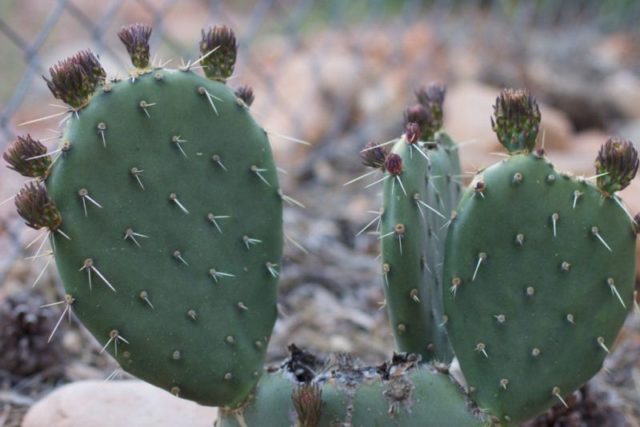
Contraindications to the use of prickly pear cactus
The benefits and harms of prickly pear are not always unambiguous. In some cases, it is not recommended to use cactus-based products. Contraindications include:
- individual intolerance;
- chronic kidney disease;
- large stones in the bladder;
- pregnancy and breastfeeding.
Tropical prickly pear juice can cause migraines, skin rashes and nausea. For the first time, cactus products are tried in small dosages, and only in the absence of side effects, they begin full-fledged treatment.
Collection and procurement
It is recommended to collect young stems-leaves of a tropical cactus, reaching the size of a human palm, for medicinal use. The skin of the blades should be green and shiny, no more than 1 cm in thickness. You need to cut off the leaves with tight gloves so that the thorns of the plant do not leave scratches on the skin.
For medicinal purposes, fresh stems are usually used, however, if desired, the raw materials can be put in the refrigerator for 2-3 weeks. For storage, the blades are packed entirely in cling film or pre-cut into pieces and closed in an airtight container.
The fruits of the prickly pear cactus are harvested in August, when they acquire a ruby red color without a green tint. These berries are easily separated from the blades and have a sweet and juicy taste. They are best consumed fresh, but you can put them in the refrigerator for a few days.
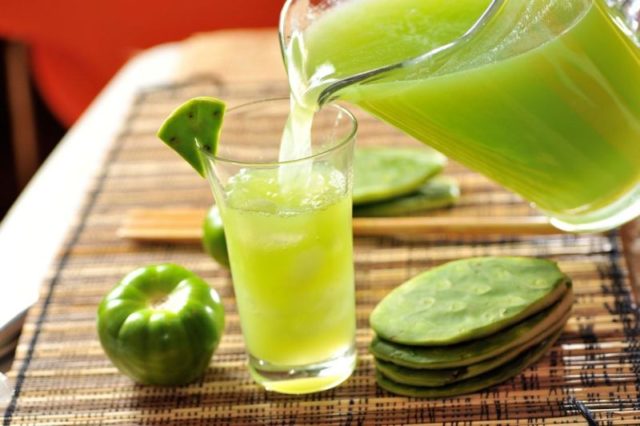
Conclusion
The medicinal properties of prickly pear cactus are beneficial for colds, coughs and inflammation. On the basis of the plant, decoctions and strong tinctures are prepared, gruel and juice effectively cope with infections and strengthen the immune system. When using drugs, it is important to observe moderate dosages.

